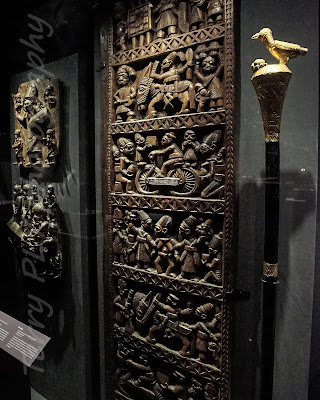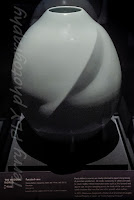I was clicking away in the dark,
taking snap shots of over 200 exhibits
at the British museum,
"Treasures of the world" exhibition.
The venue was at the National museum of Singapore.
 |
Once in a while, I get lucky enough to capture a visual statement which is a bonus.
|
Armed with only a Sony A7S camera body,
Canon 17-40mm f4L lens, Metalbone E-mount adaptor,
a 64gb SDXC UHS-1 card and a spare camera battery.
a 64gb SDXC UHS-1 card and a spare camera battery.
That's all the tools I used to overcome the restrictive nature of museum environment photography.
It's handheld camera all the way in dim ambient lighting situation.
Used of flash and tripod are prohibited.
Used of flash and tripod are prohibited.
Other challenges
include restricted subject to lens distance, view points, contrast,
high dynamic range, exposures,
glass encasement of artifacts, reflections, shutter speeds,
depth of field, extreme crop/magnifications,
human traffic and obstructions, etc.
Details are of prime importance
as first impression of exhibits can be deceiving
and only upon close examination can discover surprises.
It can even set your imagination free.
Simply a cracked inscription slap or is it?
Inverted and on closer look, I envision a wizard reading.


In the shadow, I see three lost souls.
Ultimately, the objective would be to breath life to all these inanimate objects
in the captured image form.



Museum uses tungsten light to visually enhance the 3D exhibits
with warm light and that looks great with our environmental adaptive eyes.
However, 2D still images are visually better off with close to original colour rendition.


Mostly, it's a race against time to complete the project.
"Treasures of the world" has over 200 exhibits
and need to be photographed and rough edit within a day's work.





A number of shots are photographed at restrictive acute angles,
and were edited with Light room for perspective corrections.








Visually pleasing shots can yell great satisfaction.




The British museum did a very good job in bringing the "Treasures of the world" exhibition
for the world to appreciate. It's of very high standard and quality.

All images are taken for visual appreciation only
and not for technical specifications documentation purposes.
Camera's sensitivity setting for above images are at ISO 12800, with noticeable noise presence.

My current preferred camera system is the Sony 7RII, which has 5 exis image stabiliserCamera's sensitivity setting for above images are at ISO 12800, with noticeable noise presence.

to compensate for ISO settings and hand-shake blur.
The 42 MP sensor can facilitate major image cropping and magnifications.
The Sony 90mm f2.8 macro lens can improve on
distortion, magnifications, sharpness and up to 1:1 ratio close-ups.
The new Sony 24-70mm f2.8 GM offer about 60%improvement in lens resolution
over other current lenses of the same focal length range.
That's details at new heights.
It's sharpness, lens distortion and improved image noise level reduction that I'm most interested.
As for now, I'll use whatever equipment that I can get my hands on because of budget constraint.
























































































